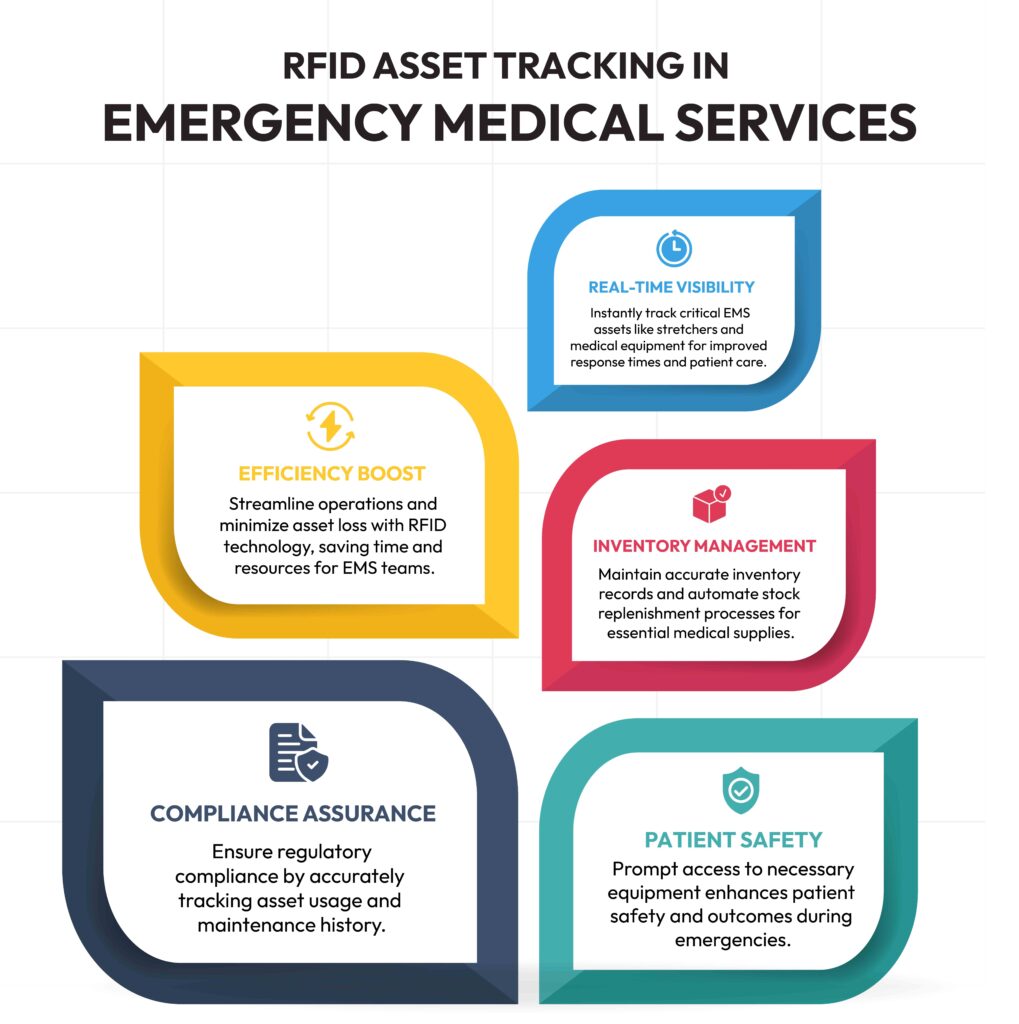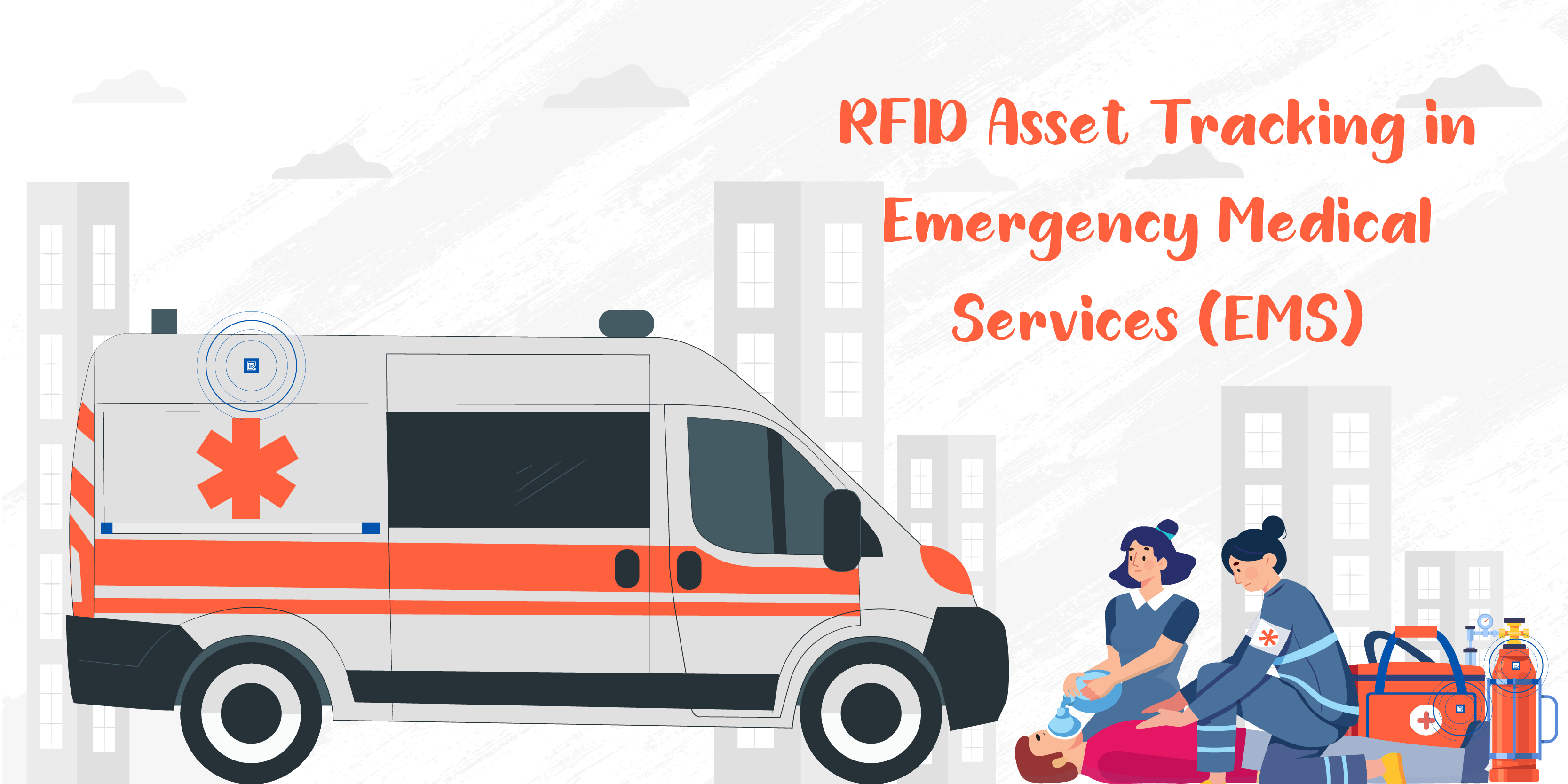I. Introduction
In the realm of Emergency Medical Services (EMS), where every second counts, efficient asset management is crucial for delivering timely and effective care to those in need. Timely access to essential medical equipment and supplies can mean the difference between life and death for patients. However, ensuring the availability and efficient management of assets in EMS environments can be challenging. That’s where RFID (Radio-Frequency Identification) technology comes into play. In this blog, we’ll explore how RFID Asset Tracking revolutionizes asset management in EMS, providing real-time visibility and accountability for crucial resources.
The ability to quickly locate and utilize essential equipment such as stretchers, radios, first aid kits, and medical tools can significantly impact response times and patient outcomes. However, managing these assets in the fast-paced environment of EMS can pose significant challenges. Enter Radio Frequency Identification (RFID) asset tracking in EMS — a game-changer in asset tracking and management for EMS organizations.
Implementing RFID technology for asset tracking in EMS requires careful planning and consideration of factors such as tag selection, reader placement, and system integration. However, the benefits of improved asset visibility, inventory control, and operational efficiency far outweigh the initial investment.
II. Understanding RFID Asset Tracking in Emergency Medical Services (EMS)
A. Definition and Purpose of RFID Asset Tracking
RFID asset tracking involves using RFID technology to monitor and manage assets in real-time. In EMS, assets such as stretchers, radios, first aid kits, and equipment are critical for delivering timely and effective care to patients. RFID asset tracking provides EMS agencies with the ability to accurately track the location, status, and usage of these assets, ensuring they are always available when needed.
B. Key Components of RFID Asset Tracking Systems
RFID Tags: These small electronic devices are attached to assets and contain unique identifiers that can be read by RFID readers.
RFID Readers: These devices emit radio waves to communicate with RFID tags and capture data from them.
Software and Data Management: RFID asset tracking systems include software that collects and manages data captured by RFID readers. This data is then analyzed to provide valuable insights into asset utilization and performance.
C. Benefits of RFID Asset Tracking in EMS
Improved Asset Visibility and Inventory Management: RFID asset tracking provides EMS agencies with real-time visibility into the location and status of assets. This enables efficient inventory management, reduces the risk of misplaced or lost assets, and ensures that critical equipment is always available when needed.
Enhanced Operational Efficiency: By automating asset tracking processes, RFID technology streamlines operations and reduces manual labor. EMS personnel can quickly locate and retrieve assets, saving time and improving response times to emergencies.
Increased Patient Safety and Care Quality: Timely access to essential equipment and supplies is vital in EMS settings. RFID asset tracking helps ensure that EMS providers have the right equipment on hand to deliver prompt and effective care to patients. This enhances patient safety and contributes to better overall outcomes.
Streamlined Maintenance and Service Records: Proper maintenance of medical equipment is essential for ensuring operational readiness and compliance with regulatory standards. RFID simplifies maintenance tracking by digitally recording asset maintenance history and service schedules. When equipment undergoes maintenance or servicing, RFID tags can be updated with relevant information, including maintenance dates, technician notes, and service records. This digital record enhances traceability and facilitates compliance with regulatory requirements, reducing the risk of equipment failure during emergencies.
Optimized Workflow Efficiency: In emergency situations, streamlined workflows can make a significant difference in patient outcomes. RFID technology streamlines asset management processes by automating data capture and eliminating manual tasks. EMS personnel can focus their efforts on patient care rather than searching for equipment, resulting in improved response times and operational efficiency. Additionally, RFID-enabled asset management systems can seamlessly integrate with existing EMS software platforms, enabling efficient data exchange and interoperability.
Asset Identification and Location Tracking: Tagging assets such as stretchers, radios, first aid kits, and equipment with RFID tags enables EMS providers to swiftly locate and track these items in real-time. RFID readers strategically positioned in EMS facilities or vehicles can scan tags as assets move in and out, maintaining an up-to-date inventory. This ensures that essential resources are readily available when needed, minimizing response times and optimizing resource allocation during emergencies.
Enhanced Asset Security: Ensuring the security of assets is paramount in EMS operations. RFID technology enhances asset security by enabling quick identification and tracking of misplaced or stolen equipment. Each RFID tag carries a unique identifier, allowing assets to be traced using RFID readers if they go missing. Moreover, integration with access control systems enables EMS organizations to restrict unauthorized access to critical equipment, safeguarding assets and ensuring compliance with security protocols.
III. Implementing RFID Asset Tracking in EMS: Challenges and Solutions
A. Identifying Assets to Track
Critical Assets in EMS (e.g., Stretchers, Radios, First Aid Kits): Before implementing RFID asset tracking, EMS agencies must identify the assets they need to track. Critical assets in EMS include stretchers for patient transport, radios for communication, first aid kits for emergency care, and various equipment used in medical procedures.
B. Overcoming Operational Challenges
Tracking Assets Across Dynamic Environments: EMS operates in dynamic and often chaotic environments, making asset tracking challenging. RFID technology, with its ability to provide real-time visibility and tracking, helps overcome this challenge by enabling EMS agencies to monitor assets regardless of location or environmental conditions.
Addressing Privacy and Security Concerns: As with any technology, RFID asset tracking raises privacy and security concerns. EMS agencies must implement measures to protect sensitive information and ensure compliance with regulations such as HIPAA. Encryption, access controls, and regular security audits are essential for safeguarding RFID data.
C. Selecting the Right RFID System
Considerations for RFID Tag Selection: Choosing the right RFID tags is crucial for successful asset tracking. Factors to consider include tag durability, size, read range, and compatibility with the assets being tracked. For example, durable and waterproof tags may be suitable for outdoor use, while smaller tags may be preferred for tracking smaller equipment.
Choosing RFID Readers and Software Solutions: When selecting RFID readers and software solutions for asset tracking, EMS agencies should carefully consider their specific needs and requirements. It’s essential to evaluate factors such as reader performance, connectivity options, software features (including data analytics and reporting), and scalability to accommodate future growth. Solutions like TagMatiks Asset Tracking and TagMatiks Asset Tracking Lite offer comprehensive RFID-based asset tracking capabilities, providing robust features for efficient data collection, analysis, and management. These solutions can help EMS agencies streamline their asset tracking processes and improve operational efficiency while ensuring accurate and timely asset management throughout their lifecycle.
D. Integration with Existing EMS Systems
Integration with Inventory Management Software: Integrating RFID asset tracking with existing inventory management software allows EMS agencies to streamline operations and improve data accuracy. Seamless integration ensures that RFID data is synchronized with inventory records, reducing manual data entry and minimizing errors.
Incorporating RFID Data into EMS Workflows: To maximize the benefits of RFID asset tracking, EMS agencies must integrate RFID data into their existing workflows. This involves training personnel on how to use RFID technology effectively and incorporating RFID data into standard operating procedures for asset management and patient care.

IV. Future Trends and Innovations in RFID Asset Tracking for EMS
A. Advancements in RFID Technology
Smaller, More Durable RFID Tags: Continued advancements in RFID technology are leading to the development of smaller and more durable RFID tags. These tags can withstand harsh environments and provide reliable tracking capabilities, even in challenging conditions.
Integration with IoT and Cloud Platforms: RFID asset tracking systems are increasingly integrating with Internet of Things (IoT) and cloud platforms. This integration enables seamless data sharing and real-time monitoring across multiple devices and locations, enhancing the scalability and flexibility of RFID solutions.
B. Predictive Maintenance and Asset Lifecycle Management
RFID asset tracking systems are evolving to include predictive maintenance and asset lifecycle management capabilities. By analyzing RFID data and equipment usage patterns, EMS agencies can proactively identify maintenance needs, predict equipment failures, and optimize asset utilization throughout their lifecycle.
C. Emerging Applications of RFID in EMS Beyond Asset Tracking
Beyond asset tracking, RFID technology has the potential to revolutionize various aspects of EMS operations. Emerging applications include patient tracking and monitoring, medication management, supply chain optimization, and emergency response coordination. These innovative uses of RFID technology have the potential to further enhance efficiency and patient care in EMS.
V. Conclusion
In this blog, we explored the significance of RFID asset tracking in Emergency Medical Services (EMS) and how it enhances operational efficiency, patient safety, and care quality. We discussed the definition and purpose of RFID asset tracking, key components of RFID systems, and the benefits it brings to EMS agencies.
RFID4U provides a comprehensive RFID asset tracking solution tailored for Emergency Medical Services (EMS). With RFID technology, EMS agencies can efficiently manage critical assets like stretchers, radios, and first aid kits. RFID4U’s solution enhances operational efficiency, improves asset visibility, and ensures timely access to essential equipment, ultimately enhancing patient care and safety in EMS operations.
Frequently Asked Questions
1. How does RFID technology ensure the security of assets in EMS?
Answer: RFID technology enhances asset security in EMS by providing real-time tracking and monitoring capabilities. RFID tags attached to assets transmit unique identifiers, allowing EMS agencies to track their location and status. This helps prevent theft or unauthorized access to critical equipment, ensuring assets are secure and accounted for at all times.
2. Can RFID asset tracking help in locating critical equipment during emergencies?
Answer: Yes, RFID asset tracking is instrumental in locating critical equipment during emergencies. By leveraging RFID tags and readers, EMS agencies can quickly locate needed assets, such as medical supplies or life-saving equipment, reducing response times and enabling prompt intervention and care for patients in critical situations.
3. What types of assets can be tracked using RFID technology in EMS?
Answer: RFID technology can track various assets used in EMS operations, including stretchers, medical equipment (such as defibrillators and monitors), medication kits, first aid supplies, and communication devices (such as radios and mobile devices). The versatility of RFID technology allows EMS agencies to monitor and manage a wide range of assets to support patient care effectively.
4. How does RFID4U's RFID asset tracking solution cater to the specific needs of Emergency Medical Services (EMS)?
Answer: RFID4U offers comprehensive RFID asset tracking solutions tailored to the unique requirements of EMS environments. With features such as real-time asset visibility, automated inventory management, and customizable reporting and analytics, RFID4U’s solutions empower EMS agencies to optimize asset management processes, enhance operational efficiency, and deliver high-quality patient care.
5. How does RFID asset tracking benefit Emergency Medical Services (EMS)?
RFID tracking helps EMS by showing where important stuff like stretchers and medical gear are at all times. This helps medics find what they need fast in emergencies, making care better and quicker. It also keeps track of how much equipment is left and reminds when to order more, stopping shortages. With RFID, managing things becomes easier, making EMS work smoother and faster, so they can help people better and faster when they need it most.
6. What types of assets can be tracked using RFID technology in EMS?
In Emergency Medical Services (EMS), RFID technology can track various types of assets critical for providing timely medical care. These assets include but are not limited to stretchers, medical equipment such as defibrillators, ventilators, and monitors, first aid kits, medication boxes, communication devices like radios or smartphones, personal protective equipment (PPE), and vehicle fleet assets such as ambulances. By tagging and tracking these assets with RFID technology, EMS organizations can ensure efficient management, timely maintenance, and readiness for emergency response, ultimately improving patient outcomes.
